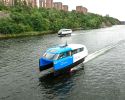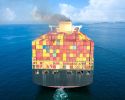Cooperation good, but not easy to achieve
Previous research has indicated that collaboration can be a successful means in order to increase energy efficiency performances and efforts. In practice it's not that easy. This according to a licentiate dissertation by Josefin Borg at Chalmers.
She herself has the experience. At the Department of Mechanics and Maritime Sciences, Josefin Borg worked for a few years as project manager and was involved in several collaborative projects between Chalmers, authorities and industry. When the opportunity appeared for her to start a doctorate, she took it.
"My employment has been shared between Chalmers and Sweship Energy during my licentiate period”, Josefin Borg says.
It is the work of Sweship Energy (a collaboration on energy efficiency between ten shipping companies operated and administered by the Swedish shipowners' assocoiation Svensk Sjöfart) that Josefin Borg has surveyed.
"I have looked at the organization and management. What are the challenges? How has the work changed over time?
In an economic perspective, there are measures relating to energy efficiency that should have been implemented by Sweship Energy companies. These differ from company to company, but for different reasons things are not getting done. And that's why the companies decided to collaborate and find a forum where they get the knowledge and support of each other. But it is easier said than done.
"Nowadays, the benefits of cooperation are often mentioned within the research literature on energy efficiency. But no one has looked at how to implement it in practice. It has been done in other research areas though, and I use that in my research.
Her studies show that there are several challenges. First, it can be difficult to get funding - within Sweship energy, much time has been spent on applying public funds.
"They are not easy to find and you have to adapt the business to the requirements of the financiers. This is an example of what is influencing the development of such a collaborative project.” Josefin Borg says.
Another challenge is to develop and find a common vision.
"The shipping companies are very different as organizations. Some have worked a lot with energy efficiency and are far ahead, while others just want to get started.
Another problem is that the environment is constantly changing. New players come in, others fall away or become less active due to funding, organizational changes or other.
"There is a lot that affects both inside and outside.”
This in turn means that it is difficult to maintain a long-term perspective. Therefore, one must often improvise without a clear plan.
"You move in the direction that works at the moment.”
At the beginning of 2018, Sweship Energy's last public financial period ended and the project is currently pretty much on hold.
"There have also been changes in the management team, and a decision has to be made, either to close down or to start all over to enter a new phase”, Josefin Borg says.
-
 DNV: Metanol är ett moget alternativt bränsle
DNV: Metanol är ett moget alternativt bränsle -
 Se Hållbar sjöfarts uppsamlingsheat
Se Hållbar sjöfarts uppsamlingsheat -
 NextWave – en podd som ska locka unga
NextWave – en podd som ska locka unga -
 Ny studie: Eldrivna pendelbåtar kan effektivisera Stockholms kollektivtrafik
Ny studie: Eldrivna pendelbåtar kan effektivisera Stockholms kollektivtrafik -
 Sjöfartens utsläpp ökar
Sjöfartens utsläpp ökar -
 Sociala relationer påverkar val av bränsle
Sociala relationer påverkar val av bränsle -
 Sjöfartens omställning kräver ”mjukare” påtryckningar
Sjöfartens omställning kräver ”mjukare” påtryckningar -
 Hon hade avtalad tid med Kapten ynkrygg
Hon hade avtalad tid med Kapten ynkrygg -
 Lighthouse omvärldsanalys 2025 – osäkerhet och tullar präglar sjöfarten
Lighthouse omvärldsanalys 2025 – osäkerhet och tullar präglar sjöfarten -
 Se seminariet Shipping in the Marine Environment
Se seminariet Shipping in the Marine Environment

